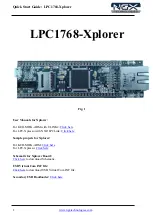
UBX-22039292 - R01
Module configuration
Page 18 of 28
C1-Public
NINA-W106
pin
ESP32 GPIO Signal function
Available from
Notes
22
GPIO1
CDC_TX
-
USB CDC RX
23
GPIO3
CDC_RX
-
USB CDC TX
24
GPIO4
GPIO4 / CAN_RX
J2-2
Needs external CAN transceiver
25
GPIO2
LED / GPIO2
J2-1
Host status LED (blue)
27
GPIO0
BOOT / GPIO0
J2-4
BOOT button, USB CDC RTS/CTS.
See also
28
GPIO5
GPIO5 / CAN_TX
J2-3
Needs external CAN transceiver.
29
GPIO18
uSD_SCK / SCK
J10-3
SPI CLK connected to microSD.
31
GPIO14
LTE_DCD
J5-4, J11-2
(unpopulated
JTAG, bottom side)
UART to LTE. See
JTAG JTMS. See
32
GPIO15
LTE_DTR
J5-5, J11-6
(unpopulated
JTAG, bottom side)
UART to LTE. See
JTAG JTDO. See
34
ADC34/GPI35 SYS_OUT_MON
-
Analog input, relative to SYS_OUT/Battery Voltage.
35
GPIO13
LTE_DSR
J5-2, J11-4
(unpopulated
JTAG, bottom side)
UART to LTE. See
JTAG JTCLK. See
36
GPIO12
LTE_RI
J5-3, J11-8
(unpopulated
JTAG, bottom side)
UART to LTE. See
JTAG JTDI. See
Table 1: NINA-W106 pinout
For further information, see also the NINA-W10 data sheet
and system integration manual
4.1.3
Auto reset circuit
XPLR-HPG-2 board includes a typical auto reset circuit that connects to the
BOOT0
and
RESET
pins
of NINA-W106, as shown in
. The circuit enables the programming tools (like
esptool.py
) to
assert the DTR and RTS control lines of the USB to Serial converter (CP2102N) and set NINA-W106
on the serial bootloader mode. More information can be found in the Espressif Automatic Bootloader
documentation
Figure 13: Auto reset circuit
☞
Capacitor C41 is not mounted on the C214 board but can be added in the application design
–
if
needed.










































